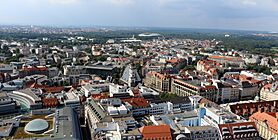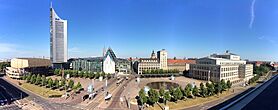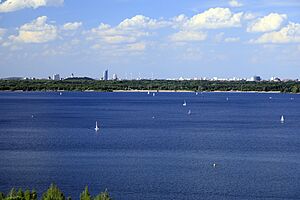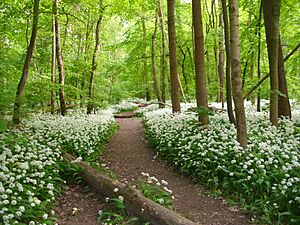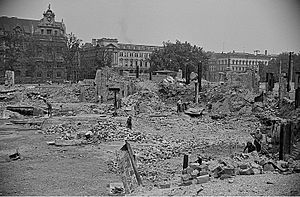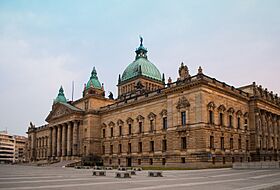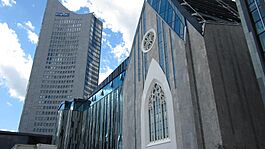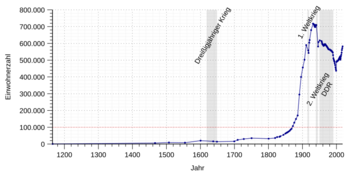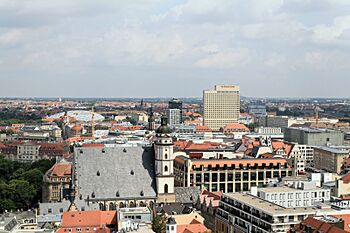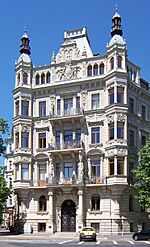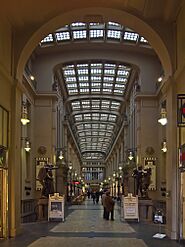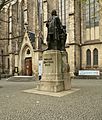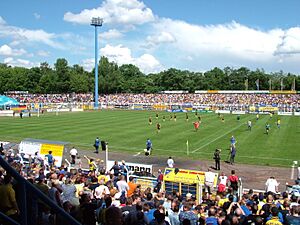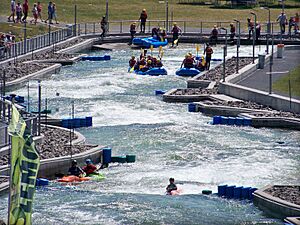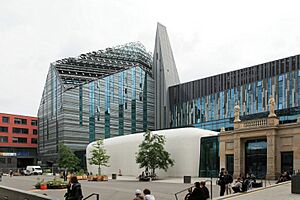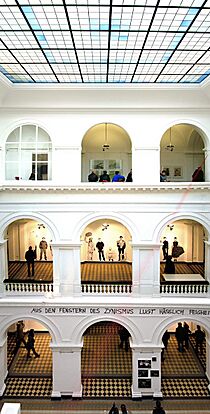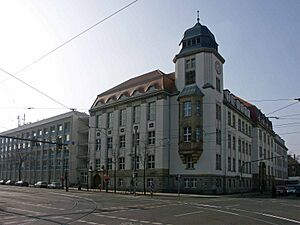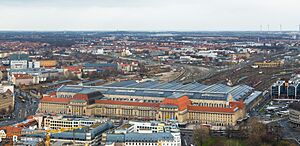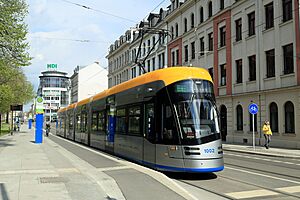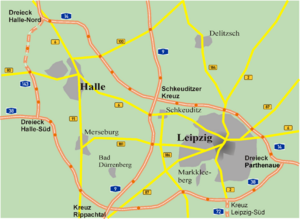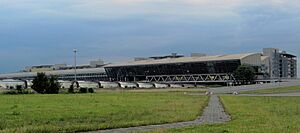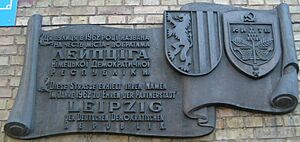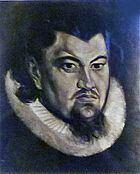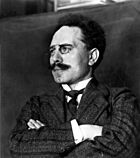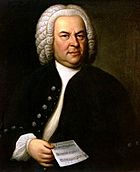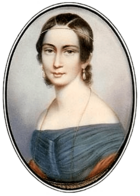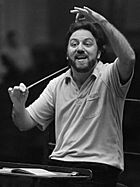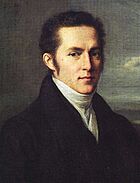Leipzig facts for kids
Quick facts for kids
Leipzig
|
|||
|---|---|---|---|
|
View over Leipzig
Monument to the Battle of the Nations
Old Town Hall
New Town Hall
Augustusplatz
|
|||
|
|||
| Country | Germany | ||
| State | Saxony | ||
| District | Urban district | ||
| Population
(2022-12-31)
|
|||
| • City | 616,093 | ||
| • Metro | 1,001,220 (LUZ) | ||
| Time zone | CET/CEST (UTC+1/+2) | ||
| Postal codes |
04001–04357
|
||
| Dialling codes | 0341 | ||
| Vehicle registration | L | ||
Leipzig is a big city in the German state of Saxony. It's the most populated city in Saxony. In 2023, about 628,718 people lived there. It's also the eighth-largest city in Germany. The name Leipzig probably comes from an old Slavic word meaning "place of linden trees."
Leipzig is about 150 kilometers (93 miles) southwest of Berlin. It sits where the White Elster river meets its smaller rivers, the Pleiße and Parthe. These rivers create a large watery area in the city. Here you can find the Leipzig Riverside Forest, which is Europe's biggest forest inside a city. Leipzig is also in the middle of Neuseenland (new lake district). This area has many artificial lakes made from old open-pit mines.
Leipzig has been an important trade city for a very long time. It was on two big medieval trade routes, the Via Regia and the Via Imperii. The city's famous trade fair started way back in 1190. From 1764 to 1945, Leipzig was a major center for publishing books. After World War II, when Germany was divided, Leipzig was a big city in East Germany. However, its cultural and economic importance became less.
In 1989, important events happened in Leipzig that helped end communism in Central and Eastern Europe. People held peaceful protests that started at St. Nicholas Church. After Germany reunited, Leipzig faced challenges like high unemployment. But by the early 2000s, the city started to get better. It has been rebuilt and its transport system has been modernized.
Leipzig is home to one of Europe's oldest universities, Leipzig University. It also has the main part of the German National Library. The Leipzig Zoo is known as one of the best zoos in Europe. In 2018, it was ranked first in Germany.
Many buildings in Leipzig were built in the late 1800s. The city's main train station, Leipzig Hauptbahnhof, is huge. It's Europe's largest railway station based on its floor area. Since 2013, the Leipzig City Tunnel has made it easier to travel around the city. It's part of Germany's largest S-Bahn (suburban train) network.
Leipzig has a long history with music. The Thomanerchor (St. Thomas Choir of Leipzig), a boys' choir, started in 1212. The Leipzig Gewandhaus Orchestra, founded in 1743, is one of the oldest orchestras in the world. Famous composers like Johann Sebastian Bach and Felix Mendelssohn lived and worked here. The Oper Leipzig, a famous opera house, was founded in 1693.
Contents
- What's in a Name?
- Leipzig's Location and Landscape
- Leipzig's History: A Journey Through Time
- Leipzig's Population and People
- Culture, Sights, and Cityscape
- Sports in Leipzig
- Education in Leipzig
- Leipzig's Economy
- Quality of Life in Leipzig
- Getting Around Leipzig
- Famous Sayings About Leipzig
- Twin Towns and Sister Cities
- Notable People from Leipzig
- See also
What's in a Name?
An older English name for Leipzig was Leipsic. The Latin name was Lipsia.
Where Did the Name Leipzig Come From?
The name Leipzig is thought to come from the Slavic word lipa. This word means "linden trees." So, the city's name is like "City of Linden Trees." This is similar to other Slavic place names in the area. Old records from around 1190 show the name Lipzk. This suggests the original Slavic name was *Lipьsko.
Fun Nicknames for Leipzig
Because of the linden tree meaning, Leipzig is sometimes called Lindenstadt or Stadt der Linden. This means "City of Linden Trees."
Another old nickname is Pleiß-Athen. This means "Athens on the Pleiße River." It shows how important Leipzig was for learning and books. It had one of Germany's oldest universities and was a center for publishing.
It's also known as "Little Paris" (Klein-Paris). This nickname comes from Johann Wolfgang von Goethe's play Faust I. Part of the play takes place in Leipzig's famous restaurant, Auerbachs Keller.
In 1937, the Nazi government officially changed the city's name. They called it Reichsmessestadt Leipzig, which meant "Imperial Trade Fair City Leipzig."
In 1989, Leipzig was called a Hero City. This was because the Monday protests there helped bring down the East German government.
More recently, people have called Leipzig Hypezig. It's also known as the "Boomtown of eastern Germany." Some even call it "The better Berlin" (Das bessere Berlin). This is because it's a cool city with a lively atmosphere and many new businesses.
Leipzig's Location and Landscape
Where is Leipzig Located?
Leipzig is in the Leipzig Bay, which is the southernmost part of the North German Plain. The city is on the White Elster river. This river starts in the Czech Republic and flows into the Saale river. The Pleiße and the Parthe rivers also join the White Elster in Leipzig. Together, they form a large watery area called Leipziger Gewässerknoten.
This area has many swampy parts, like the Leipzig Riverside Forest (Leipziger Auenwald). The land is mostly flat.
Even though there are some forest parks in the city, the area around Leipzig doesn't have many trees. In the 1900s, there were many open-pit mines here. Most of these have now been turned into lakes, creating the Neuseenland.
Leipzig is also located where two old trade roads met. These were the Via Regia (King's highway) and the Via Imperii (Imperial highway).
In the Middle Ages, Leipzig was a walled city. The "ring" road around the old city center today follows where those old walls used to be.
How Leipzig is Divided
Since 1992, Leipzig has been split into ten main areas called Stadtbezirke (boroughs). These boroughs are then divided into 63 smaller areas called Ortsteile (localities). Some of these smaller areas used to be separate villages that became part of Leipzig.
Leipzig's Weather
Leipzig has a climate that is influenced by both the ocean and the land. Winters are cold, with an average temperature of about 1°C (34°F). Summers are generally warm, averaging 19°C (66°F). Daytime temperatures in summer are around 24°C (75°F). It rains more in the summer than in the winter. The city gets much more sunshine in summer than in winter. For example, December has about 51 hours of sunshine, while July has about 229 hours.
| Climate data for Leipzig (Leipzig/Halle Airport) (1991–2020 normals, extremes 1973–2013) | |||||||||||||
|---|---|---|---|---|---|---|---|---|---|---|---|---|---|
| Month | Jan | Feb | Mar | Apr | May | Jun | Jul | Aug | Sep | Oct | Nov | Dec | Year |
| Record high °C (°F) | 15.9 (60.6) |
18.6 (65.5) |
23.0 (73.4) |
29.5 (85.1) |
31.9 (89.4) |
34.8 (94.6) |
36.6 (97.9) |
37.2 (99.0) |
34.9 (94.8) |
28.2 (82.8) |
18.7 (65.7) |
16.5 (61.7) |
37.2 (99.0) |
| Mean daily maximum °C (°F) | 3.6 (38.5) |
5.0 (41.0) |
9.1 (48.4) |
14.7 (58.5) |
19.1 (66.4) |
22.5 (72.5) |
25.0 (77.0) |
24.6 (76.3) |
19.7 (67.5) |
14.1 (57.4) |
8.0 (46.4) |
4.5 (40.1) |
14.2 (57.6) |
| Daily mean °C (°F) | 1.0 (33.8) |
1.7 (35.1) |
4.9 (40.8) |
9.6 (49.3) |
13.9 (57.0) |
17.3 (63.1) |
19.5 (67.1) |
19.2 (66.6) |
14.8 (58.6) |
9.9 (49.8) |
5.1 (41.2) |
2.0 (35.6) |
9.9 (49.8) |
| Mean daily minimum °C (°F) | −1.8 (28.8) |
−1.5 (29.3) |
1.0 (33.8) |
4.4 (39.9) |
8.5 (47.3) |
11.9 (53.4) |
14.1 (57.4) |
14.0 (57.2) |
10.2 (50.4) |
6.2 (43.2) |
2.3 (36.1) |
−0.6 (30.9) |
5.7 (42.3) |
| Record low °C (°F) | −27.6 (−17.7) |
−21.6 (−6.9) |
−16.6 (2.1) |
−6.5 (20.3) |
−2.6 (27.3) |
1.8 (35.2) |
5.7 (42.3) |
5.5 (41.9) |
0.5 (32.9) |
−6.7 (19.9) |
−12.9 (8.8) |
−20.2 (−4.4) |
−27.6 (−17.7) |
| Average precipitation mm (inches) | 33.4 (1.31) |
24.5 (0.96) |
36.5 (1.44) |
32.0 (1.26) |
51.2 (2.02) |
54.4 (2.14) |
75.8 (2.98) |
63.6 (2.50) |
50.5 (1.99) |
35.2 (1.39) |
40.4 (1.59) |
34.3 (1.35) |
531.9 (20.94) |
| Average precipitation days (≥ 1.0 mm) | 15.7 | 12.6 | 14.2 | 11.1 | 12.7 | 12.7 | 13.9 | 13.0 | 11.8 | 13.3 | 14.5 | 15.3 | 160.8 |
| Average snowy days (≥ 1.0 cm) | 8.1 | 7.7 | 3.7 | 0.6 | 0 | 0 | 0 | 0 | 0 | 0.1 | 1.4 | 4.9 | 26.5 |
| Average relative humidity (%) | 82.3 | 79.0 | 74.3 | 67.5 | 67.8 | 67.8 | 66.7 | 68.1 | 75.4 | 80.9 | 84.5 | 83.8 | 74.8 |
| Mean monthly sunshine hours | 61.9 | 81.0 | 128.5 | 190.9 | 231.4 | 229.9 | 233.9 | 219.6 | 163.9 | 119.3 | 64.9 | 53.3 | 1,748.8 |
| Source 1: World Meteorological Organization | |||||||||||||
| Source 2: Data derived from Deutscher Wetterdienst, note | |||||||||||||
Leipzig's History: A Journey Through Time
How Leipzig Began
Leipzig was first mentioned in writing in 1015. It was given city and market rights in 1165. The Leipzig Trade Fair started in the Middle Ages. It became a very important international event. This helped Leipzig's merchants become successful.
Records from 1305 show that people were fishing in the Pleiße river near Leipzig. The city also had several monasteries. One was a Franciscan monastery.
Leipzig University was founded in 1409. Leipzig then became a key place for German law and publishing. This led to important courts and libraries being located there later.
During the Thirty Years' War, two battles happened near Leipzig. These were the first Battle of Breitenfeld in 1631 and the second in 1642. Both were wins for the Swedish side.
In 1701, Leipzig became one of the first cities to have oil-fueled street lights. There were 700 lanterns, and special guards made sure they were lit on time.
Leipzig in the 1800s
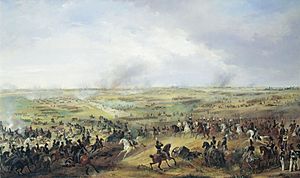
In 1813, a huge battle took place near Leipzig. It was called the Battle of Leipzig. Napoleon's French army fought against armies from Prussia, Russia, Austria, and Sweden. This was the biggest battle in Europe before World War I. The allies won, which ended Napoleon's power in Germany. The Monument to the Battle of the Nations was finished in 1913 to remember this event.
In 1839, Leipzig became a major railway center. It was the end point for Germany's first long-distance railway to Dresden. Leipzig Hauptbahnhof became Europe's largest train station by area.
In the 1800s, Leipzig was also a center for German liberal movements. Germany's first labor party was founded here in 1863. Leipzig grew very quickly, reaching over 700,000 people. Many large buildings were constructed during this time.
Leipzig in the 1900s
In 1907, the Leipziger Baumwollspinnerei became the biggest cotton mill in Europe. It produced over 5 million kilograms of yarn each year.
During World War I, the American Consulate in Leipzig closed. It became a temporary home for Americans and Allied refugees.
Music was very important in Leipzig in the 1930s and 1940s. Many students went to the Felix Mendelssohn Bartholdy College of Music and Theatre. It closed during World War II but reopened in 1945.
In 1930, Carl Friedrich Goerdeler became mayor. He later opposed the Nazi government. He resigned in 1937 after his Nazi deputy ordered the destruction of a statue of Felix Mendelssohn. In 1938, during Kristallnacht, the beautiful Leipzig synagogue was destroyed. Goerdeler was later executed by the Nazis in 1945.
During World War II, Leipzig was heavily bombed by Allied planes. The first big raid was on December 4, 1943. Large parts of the city center were destroyed. The fighting in Leipzig was very tough. American troops captured the city in April 1945.
After the war, the United States handed the city over to the Red Army. Leipzig became a major city in East Germany. The city's trade fair became important again. It was a place for East Germany to connect with other countries.
However, East Germany's planned economy was not good for Leipzig. The city focused too much on heavy industry, which caused a lot of pollution. Many creative businesses moved away. Between 1950 and 1990, Leipzig's population dropped from 600,000 to 500,000.
In October 1989, peaceful protests started at St. Nicholas Church. These Monday demonstrations were a big part of the fall of the East German government. After Germany reunited, Leipzig faced new problems. Many factories closed, and unemployment was very high. About 100,000 people left Leipzig in the ten years after reunification.
Starting in 2000, Leipzig began to rebuild. The city focused on restoring its historic downtown area. It also worked to attract new industries and improve its transport. This helped the city's population start to grow again.
Leipzig in the 2000s
Leipzig is now an important economic center in Germany. Since the 2010s, it's been called a "hip" city with a great quality of life. Some even call it "The new Berlin." Leipzig is also Germany's fastest-growing city.
Leipzig tried to host the 2012 Summer Olympics but wasn't chosen. In 2013, the Leipzig City Tunnel opened. This tunnel is a key part of the S-Bahn Mitteldeutschland public transport system. This system connects Leipzig to other states like Saxony-Anhalt and Thuringia.
Leipzig's Population and People
Leipzig has about 620,000 people. Its population was highest in 1930, with over 700,000 residents. It then slowly went down until 1989. In the 1990s, the population dropped quickly. Many people moved away or to the suburbs.
After the city grew in size in 1999, the population became stable. It started to grow again in 2000. As of 2015, Leipzig is the fastest-growing city in Germany for cities with over 500,000 people. This growth is mostly because more people are moving into the city.
After Germany reunited, many young people moved to West Germany for jobs. This also led to fewer babies being born. But since the late 1990s, the number of births in Leipzig has gone up.
The number of people from other countries in Leipzig is lower than in many other German cities. However, the number of people with an immigrant background has grown. In 2016, about 13.3% of the city's population had an immigrant background.
Culture, Sights, and Cityscape
In the 2010s, Leipzig was often called Hypezig. This was because it was compared to Berlin in the 1990s. The city is affordable and open. This has attracted many young people from all over Europe. It has led to a cool music, dance, and art scene.
Leipzig's Buildings and Design
Leipzig's old city center has many beautiful buildings from the 1500s. These include the old city hall in the marketplace. There are also fancy trading houses and homes of rich merchants from the Baroque period. Leipzig grew a lot in the late 1800s. So, many buildings are in the historicist style from that time. About 35% of Leipzig's apartments are in these types of buildings. The new city hall, finished in 1905, is built in a similar style.
During Communist rule in East Germany, about 90,000 apartments were built using a style called Plattenbau. These are buildings made from large, pre-made concrete slabs. Some of these have been taken down, but many people still live in them.
The St. Paul's Church was destroyed by the Communist government in 1968. A new building for the university, called Paulinum, was built in its place. It was finished in 2012. Its design looks like the old church. It also has space for religious use and the original altar from the old church.
Tallest Buildings and Structures
The tallest structure in Leipzig is a chimney. It belongs to a company called Stahl- und Hartgusswerk Bösdorf GmbH. It is 205 meters (673 feet) tall. The tallest building in Leipzig is the City-Hochhaus Leipzig, at 142 meters (466 feet). From 1972 to 1973, it was Germany's tallest building.
Museums and Art in Leipzig
One important art event in Leipzig was the Neo Rauch art show in 2010. It was at the Leipzig Museum of Fine Arts. Neo Rauch is a famous artist from the "New Leipzig School." There are also eleven art galleries in a place called the Spinnerei.
The Grassi Museum has three big collections. These are the Ethnography Museum, Applied Arts Museum, and Musical Instrument Museum. The university also has a Museum of Antiquities.
The G2 Kunsthalle opened in 2015. It has the Hildebrand Collection, which focuses on the "New Leipzig School." The Galerie für Zeitgenössische Kunst Leipzig also shows modern art.
Other museums in Leipzig include:
- The German Museum of Books and Writing: The oldest museum of its kind in the world.
- The Egyptian Museum of the University of Leipzig: Has about 7,000 ancient Egyptian items.
- The Schillerhaus: The house where the writer Schiller lived in 1785.
- The Zeitgeschichtliches Forum Leipzig (Forum of Contemporary History): Shows the history of Germany's division.
- Naturkundemuseum Leipzig: The city's natural history museum.
- The Leipzig Panometer: A huge panorama picture inside an old gas tank.
- The "Museum in der Runden Ecke": Shows how the secret police (Stasi) worked in East Germany.
- The Bach Archive: Studies the life and work of Johann Sebastian Bach.
- Mendelssohn House: The home of Felix Mendelssohn from 1845 to 1847.
- Schumann House: The home of Robert and Clara Schumann from 1840 to 1844.
Main Sights to See
- Leipzig Zoological Garden: One of Europe's most modern zoos. It has the world's largest area for primates (Pongoland). Gondwanaland is the world's largest indoor rainforest.
- Monument to the Battle of the Nations (Völkerschlachtdenkmal): One of Europe's largest monuments. It remembers the battle against Napoleon's troops.
- Bundesverwaltungsgericht: Germany's federal administrative court.
- New Town Hall: The city's main administrative building. It's built where an old castle used to be. It's also Germany's tallest town hall.
- Old Town Hall: Built in 1556, it's on the Market square. It now holds a museum about the city's history.
- City-Hochhaus Leipzig: Built in 1972, it's the city's tallest building you can live or work in.
- The Augusteum and Paulinum: These are the new main buildings for Leipzig University.
- Leipzig Trade Fair center: Has the world's largest glass hall that seems to float.
- Leipzig Hauptbahnhof: The world's largest railway station by floor area. It's also a shopping spot.
- Auerbach's Cellar: A famous basement restaurant. Johann Wolfgang von Goethe visited it when he was a student.
- The Old Leipzig bourse: An old stock exchange building.
- South Cemetery: The largest cemetery in Leipzig.
- The German National Library: One of Germany's national libraries.
- Leipzig Bayerischer Bahnhof: Germany's oldest preserved railway station.
- Gohlis Palace (Gohliser Schlösschen).
- Leipzig Synagogue Memorial: A memorial stands where the synagogue was destroyed in 1938.
Churches in Leipzig
- St. Thomas's Church (Thomaskirche): Famous because Johann Sebastian Bach worked here as a music director. It's also home to the famous boys' choir, Thomanerchor.
- St. Nicholas's Church (Nikolaikirche): Bach also worked here. The weekly "Monday prayer" held here started the peaceful Monday protests against the East German government in the 1980s.
- St. Peter's: Has the tallest church tower in Leipzig, at 87 meters (285 feet).
- The new Propsteikirche: Opened in 2015.
- The Continental Reformed Church of Leipzig (Evangelisch-reformierte Kirche): A prominent building on the city's inner ring road.
- The Russian Church of Leipzig.
- St. Michael's Church: A landmark in the Gohlis district.
Parks and Lakes for Fun
Leipzig is known for its many large parks. The Leipziger Auwald (riparian forest) is mostly within the city. Neuseenland is an area south of Leipzig where old mines are becoming a huge lake district. It's planned to be finished by 2060.
- Leipzig Botanical Garden: The oldest of its kind in Germany. It has about 7,000 plant species.
- Johannapark and Clara-Zetkin-Park: The most famous parks in Leipzig's city center.
- Leipziger Auwald: Covers about 2,500 hectares (6,178 acres). The Rosental is a park in this forest, next to Leipzig Zoo.
- The Leipzig Wildlife Park: In Connewitz, it shows 25 different animal species.
Music in Leipzig
Classical and Modern Music
Johann Sebastian Bach lived and worked in Leipzig for a long time. He was the music director for the Thomanerchor (St. Thomas Church Choir) at St. Thomas Church. The composer Richard Wagner was born in Leipzig in 1813. Robert Schumann also worked in Leipzig. Felix Mendelssohn started Germany's first music school here in 1843.
Today, this school is the University of Music and Theatre Leipzig. It teaches many subjects like instruments, singing, and conducting. It also has drama departments for acting and scriptwriting.
The Bach-Archiv Leipzig studies the life and work of Bach. It also organizes the International Johann Sebastian Bach Competition. This competition is held every two years. The Bach-Archiv also puts on performances, like the Bachfest Leipzig festival.
Leipzig's music tradition is also seen in the famous Leipzig Gewandhaus Orchestra. The MDR Leipzig Radio Symphony Orchestra is another big orchestra in the city. Both orchestras perform at the Gewandhaus concert hall.
For over 60 years, Leipzig has offered "school concerts" for children. More than 40,000 children attend these concerts each year.
Contemporary Music Scene
Leipzig is known for its independent music and cool events. For 30 years, Leipzig has hosted the Wave-Gotik-Treffen (WGT). This is the world's largest Gothic festival. Thousands of fans of goth music gather here every early summer.
Die Prinzen ("The Princes") is a German band from Leipzig. They have sold almost six million records. This makes them one of Germany's most successful bands.
Till Lindemann, the lead singer of the band Rammstein, was born in Leipzig.
-
Monument of Johann Sebastian Bach
Annual Events and Festivals
- Auto Mobil International (AMI): A big motor show.
- A cappella: A festival for vocal music.
- Bachfest: A festival celebrating Johann Sebastian Bach.
- Leipzig Christmas Market: Held since 1458.
- Dok Leipzig: An international festival for documentary and animated films.
- Jazztage: A modern jazz festival.
- Ladyfest Leipzig: A feminist punk and electro festival.
- Leipzig Book Fair: The second largest book fair in Germany.
- Lichtfest Leipzig: A festival celebrating the protests that led to the fall of East Germany.
- Stadtfest: The city festival.
- Wave-Gotik-Treffen: The world's largest goth festival.
- Chaos Communication Congress: A big meeting for computer hackers and tech fans.
Food and Drink in Leipzig
- Leipziger Allerlei: A local stew with seasonal vegetables and crayfish.
- Leipziger Lerche: A sweet pastry filled with almonds, nuts, and strawberry jam. The name means "Leipzig lark." It comes from a time when lark meat pies were a local specialty.
- Gose: A special sour beer brewed in Leipzig.
Sports in Leipzig
Leipzig has over 300 sports clubs and 78 different sports. There are more than 400 sports facilities for people to use.
Football (Soccer)
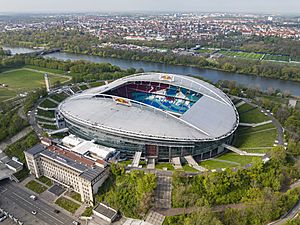
The German Football Association (DFB) was started in Leipzig in 1900. Leipzig hosted some matches for the 2006 FIFA World Cup.
VfB Leipzig won the first German football championship in 1903. Later, the club became 1. FC Lokomotive Leipzig. This club had success in international games.
In 2009, Red Bull took over a local football club. They renamed it RB Leipzig. The club quickly moved up through the German football leagues. In 2016, they were promoted to the Bundesliga, Germany's top league. RB Leipzig won the DFB-Pokal (German Cup) in 2022 and 2023.
Other Popular Sports
SC DHfK Leipzig is the men's handball club. They won the East German handball league many times. They also won the EHF Champions League in 1966. They play in the Arena Leipzig.
Handball-Club Leipzig is one of Germany's most successful women's handball clubs. They have won 21 national championships.
The Leipzig Kings are an American football team. They play in the European League of Football (ELF).
The Motodrom am Cottaweg is a stadium for motorcycle speedway.
Leipzig hosted the Fencing World Cup in 2005. It also hosts many other international sports events.
Leipzig tried to host the 2012 Summer Olympics but was not chosen.
Markkleeberger See is a new lake near Leipzig. It used to be an open-pit coal mine. Now it's a tourist area. It has Germany's only pump-powered artificial whitewater course. This course is called Markkleeberg Canoe Park. It's used for training and international canoe/kayak races.
Leipzig hosted the Indoor Hockey World Cup in 2015.
Education in Leipzig
Leipzig University
Leipzig University was founded in 1409. It is one of Europe's oldest universities. Many famous people have studied or worked here. These include the philosopher Gottfried Wilhelm Leibniz and the physicist Werner Heisenberg. The university has about 30,000 students.
The German Institute for Literature is part of Leipzig University. Many well-known writers have graduated from this school.
Art and Theatre Schools
The Academy of Visual Arts (Hochschule für Grafik und Buchkunst) started in 1764. It teaches painting, graphics, photography, and media art.
The University of Music and Theatre teaches many subjects. These include musical instruments, singing, and conducting. It also has programs for acting and scriptwriting.
Other Universities and Research
The Leipzig University of Applied Sciences (HTWK) is the second-biggest higher education school in Leipzig. It focuses more on practical education. It offers many engineering courses, computer science, and business.
The private Leipzig Graduate School of Management is Germany's oldest business school.
Lancaster University Leipzig is a branch campus of a UK university. It opened in 2020 and has students from many countries.
Leipzig is home to several important research institutes. These include institutes from the Max Planck Society and the Fraunhofer Society.
One of the world's oldest schools, Thomasschule zu Leipzig (St. Thomas' School), is in Leipzig. It is famous for its connection to the Bach family of musicians.
Leipzig's Economy
Leipzig is a center for making cars. BMW and Porsche have large factories north of the city. DHL moved most of its European air operations to Leipzig/Halle Airport. Kirow Ardelt AG, a world leader in breakdown cranes, is based in Leipzig.
The city also has the European Energy Exchange. This is a main energy trading center in Central Europe. VNG – Verbundnetz Gas AG, a big natural gas supplier, is also in Leipzig.
Some of the biggest employers are software companies like Spreadshirt. The many schools and universities in the area also employ many people. Leipzig University brings in millions of euros each year.
Leipzig is also known for medical research and a growing biotechnology industry.
Many tourists visit Leipzig. The city's downtown area has many bars, restaurants, and shops. Leipzig Hauptbahnhof also has a shopping mall. In 2017, over 3 million people stayed overnight in Leipzig.
In 2010, The New York Times listed Leipzig as one of the top 10 cities to visit. In 2015, Leipzig had the third-best future outlook among German cities. It's often called the "Boomtown of eastern Germany" or "Hypezig." As of 2013, it had the fastest population growth of any German city.
Companies with operations in or around Leipzig include:
-
Höfe am Brühl shopping mall, situated on the former route of Via Regia, an ancient trade road
Quality of Life in Leipzig
In 2013, a study said Leipzig was the most livable city in Germany.
In 2015/2016, Leipzig was named the second-best city for students in Germany.
A 2017 study found that Leipzig's inner city was the best among large German cities. This was because of its beauty, restaurants, and shopping.
According to a 2017 study, Leipzig was one of the least stressful cities in the world. It was ranked 25th out of 150 cities.
Leipzig was named European City of the Year in 2019.
A 2019 study said Leipzig is the most dynamic region in Germany. It climbed 230 places in 15 years.
The New York Times listed Leipzig as one of 52 places to visit in 2020.
Leipzig Hauptbahnhof has been ranked the best railway station in Germany. It's the third-best in Europe.
Getting Around Leipzig
Leipzig has always been a major crossroads for trade and travel. After Germany reunited, a lot of work was done to improve the transport network. Now, the city has excellent ways to get around.
Trains and Railways
Leipzig Hauptbahnhof (main station) opened in 1915. It is the largest train station in Europe by its built-up area. It's a key hub for fast Intercity-Express (ICE) trains. It also connects to local S-Bahn and regional trains.
Fast trains from Berlin, Munich, Dresden, and Frankfurt all pass through Leipzig. There are also direct regional trains to many towns in Saxony. The only international train goes to Prague.
Train connections are getting even better. The line to Berlin is now faster. A new high-speed line to Erfurt opened in 2015. This makes trips to Nuremberg, Munich, and Frankfurt much quicker. The old Leipzig-Dresden line is also being improved.
The most important project was the city tunnel. It opened in 2013. This tunnel goes under the city center. It connects the main station to the south of the city.
There are also freight train stations for goods.
Suburban Trains (S-Bahn)
Leipzig is the center of the S-Bahn Mitteldeutschland train network. Six of its ten lines are a main part of public transport. They connect Leipzig to nearby Halle and the region. The main S-Bahn line goes through the City Tunnel. Its stations are underground. There are 30 S-Bahn stations in Leipzig.
The S-Bahn network was updated in 2013. The City Tunnel, almost four kilometers (2.5 miles) long, crosses the city center. This tunnel created a continuous north-south route.
Trams and Buses
The Leipziger Verkehrsbetriebe operates 15 tram lines and 47 bus lines.
The tram network is 146 kilometers (91 miles) long. This makes it the largest in Saxony. The longest tram line is line 11. It connects Schkeuditz with Markkleeberg.
Night buses and night trams also run. The main place to switch between buses, trams, and S-Bahn is Leipzig Central Station.
Biking in Leipzig
Like many German cities, Leipzig is good for bikes. It has a large network of bike paths. In most one-way streets in the center, bikes can go both ways.
Since 2004, there's been a bicycle-sharing system. You can borrow and return bikes using a smartphone app. Since 2018, you can pick up and drop off bikes almost anywhere in the city center. Outside the center, there are special stations.
Roads and Car Sharing
Several major highways pass by Leipzig. These are the A 14 (north), A 9 (west), and A 38 (south). These highways form a partial ring around Leipzig and Halle.
The inner city ring road follows the path of the old city walls. The city center is mostly calm for traffic.
Leipzig has many carsharing stations. Since 2018, there's also a system where you can find and book cars anywhere in the inner city using an app.
Long-Distance Buses
Since 2018, there's a central bus station east of Leipzig Central Station.
Many national and international bus lines serve Leipzig. You can reach cities like Prague, Budapest, and Milan directly.
Air Travel
Leipzig/Halle Airport is the international airport for the region. It's located northwest of Leipzig. It has a train station for long-distance trains.
Flights go to major German airports, European cities, and holiday spots. The airport is very important for cargo flights. DHL uses it as its main European hub.
Waterways
In the early 1900s, work started to connect Leipzig to a network of waterways. This included the Elster-Saale canal. The rivers in Leipzig mostly have artificial beds. They are also connected by some channels. These waterways are only for small boats.
The city is working to expand its water network. They are renovating old waterways and flooding old mines. A connection between the Karl Heine Canal and the Lindenauer port opened in 2015. The goal is to allow small boats to reach the Elbe river from Leipzig.
Famous Sayings About Leipzig
- Mein Leipzig lob' ich mir! Es ist ein klein Paris und bildet seine Leute. ("I praise my Leipzig! It is a small Paris and educates its people.") – Frosch, a student in Goethe's Faust, Part One
- Ich komme nach Leipzig, an den Ort, wo man die ganze Welt im Kleinen sehen kann. ("I'm coming to Leipzig, to the place where one can see the whole world in miniature.") – Gotthold Ephraim Lessing
- Extra Lipsiam vivere est miserrime vivere. ("To live outside Leipzig is to live miserably.") – Benedikt Carpzov the Younger
Twin Towns and Sister Cities
Leipzig has special friendships with other cities around the world. These are called twin towns or sister cities:
 Addis Ababa, Ethiopia (2004)
Addis Ababa, Ethiopia (2004) Birmingham, United Kingdom (1992)
Birmingham, United Kingdom (1992) Bologna, Italy (1962)
Bologna, Italy (1962) Brno, Czech Republic (1973)
Brno, Czech Republic (1973) Frankfurt, Germany (1990)
Frankfurt, Germany (1990) Hanover, Germany (1987)
Hanover, Germany (1987) Herzliya, Israel (2010)
Herzliya, Israel (2010) Ho Chi Minh City, Vietnam (2021)
Ho Chi Minh City, Vietnam (2021) Houston, United States (1993)
Houston, United States (1993) Kraków, Poland (1973)
Kraków, Poland (1973) Kyiv, Ukraine (1961)
Kyiv, Ukraine (1961) Lyon, France (1981)
Lyon, France (1981) Nanjing, China (1988)
Nanjing, China (1988) Thessaloniki, Greece (1984)
Thessaloniki, Greece (1984) Travnik, Bosnia and Herzegovina (2003)
Travnik, Bosnia and Herzegovina (2003)
Notable People from Leipzig
Politicians
- Nikolaus Krell (1551–1601), a chancellor.
- Louise Otto-Peters (1819–1895), a leader for women's rights.
- August Bebel (1840–1913), a socialist politician.
- Karl Liebknecht (1871–1919), a socialist politician.
- Carl Friedrich Goerdeler (1884–1945), mayor and an opponent of Hitler.
- Walter Ulbricht (1893–1973), a Communist politician and leader of East Germany.
- Annemarie Renger (1919–2008), a politician who was President of the Bundestag.
Philosophers and Thinkers
- Gottfried Wilhelm Leibniz (1646–1716), a famous philosopher and mathematician.
- Christian Thomasius (1655–1728), a lawyer and philosopher.
Writers and Artists
- Johann Sebastian Bach (1685–1750), a very famous composer.
- Carl Philipp Emanuel Bach (1714–1788), a musician and composer.
- Johann Christian Bach (1735–1782), a composer and son of Johann Sebastian Bach.
- Friedrich Arnold Brockhaus (1772–1823), a publisher who started the Brockhaus encyclopedia.
- Felix Mendelssohn (1809–1847), a composer, pianist, and conductor.
- Robert Schumann (1810–1856), a composer and music critic.
- Richard Wagner (1813–1883), a famous composer.
- Clara Schumann (1819–1896), a pianist and composer.
- Max Beckmann (1884–1950), an expressionist painter.
- Kurt Masur (1927–2015), a conductor of the Leipzig Gewandhaus Orchestra.
- Riccardo Chailly (born 1953), a conductor.
- Neo Rauch (born 1960), a painter.
- Till Lindemann (born 1963), the lead singer of the band Rammstein.
- Simone Thomalla (born 1965), an actress.
- Bill Kaulitz (1989-), a singer and songwriter.
- Tom Kaulitz (1989-), a guitarist.
Scientists and Business People
- Carl Gustav Carus (1789–1869), a doctor and painter.
- Wilhelm Hofmeister (1824–1877), a biologist and botanist.
- Karl Wittgenstein (1847–1913), a businessman.
Sports Figures
- Kristin Otto (born 1966), a swimmer who won six Olympic gold medals.
- Arthur ''Saxon'' Hennig (born 1871), a strongman and circus performer.
See also
 In Spanish: Leipzig para niños
In Spanish: Leipzig para niños


